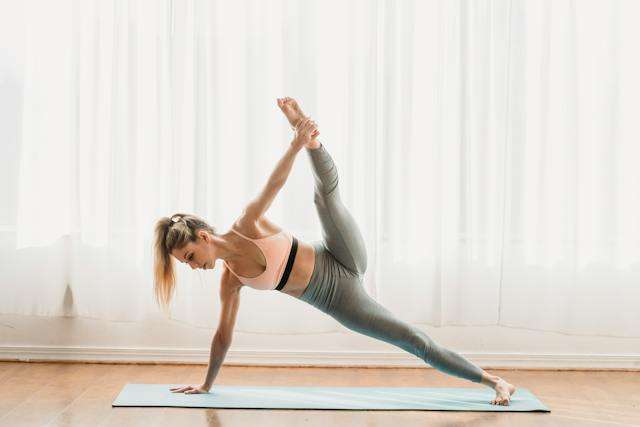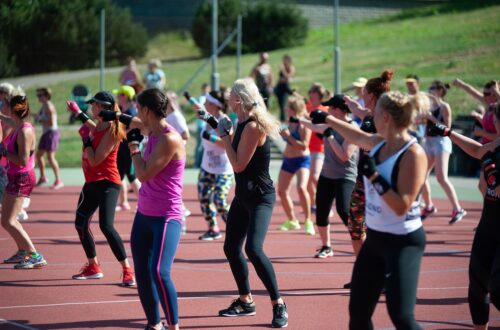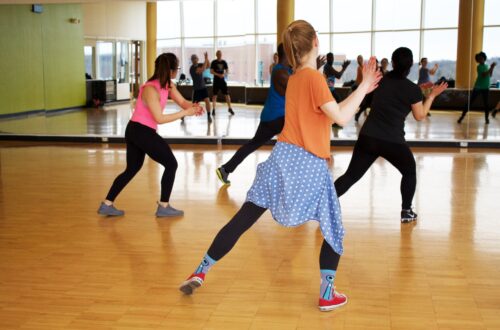
Boost Your Weight Loss with a Quick and Effective 15-Minute Cardio Workout
Hey there, fitness enthusiast! If you’re on a quest to shed those extra pounds but find yourself short on time, worry not – we’ve got your back. Say goodbye to the notion that effective workouts must be lengthy and complicated. In this blog post, we’re about to spill the beans on a quick and super-effective cardio routine that’s perfect for anyone with a jam-packed schedule.
Say goodbye to excuses and hello to your new workout BFF – a 15-minute cardio session designed to make your weight loss dreams a reality. So, grab your workout gear, and let’s dive into a fitness adventure that’s short on time but big on results! So, lace up those sneakers, and let’s dive into a workout that’s as fun as it is effective!
The Significance of Cardio for Weight Loss:
Cardiovascular exercises, often referred to as cardio, play a pivotal role in weight loss and overall well-being. These exercises elevate your heart rate, burn calories, and improve the efficiency of your cardiovascular system. Engaging in regular cardio activities helps create a calorie deficit, essential for weight loss, by burning more calories than consumed. Additionally, cardio exercises enhance metabolism, making it easier for the body to burn stored fat.
Cardiovascular workouts come in various forms, including running, cycling, swimming, and aerobics. Incorporating them into your routine not only aids in weight loss but also contributes to increased stamina, improved mood, and reduced risk of chronic diseases.
Brief Overview of the 15-minute exercise routine:
Get ready for a fitness revolution! We’re about to unveil a transformative 15-minute Exercise routine designed to kickstart your metabolism, burn calories, and sculpt your body. This high-intensity yet time-efficient workout combines cardio and strength exercises to maximize the benefits in a short amount of time.
Imagine dedicating just 15 minutes of your day to an invigorating routine that not only supports your weight loss goals but also leaves you feeling energized and accomplished. Stay tuned for a dynamic sequence of exercises that you can seamlessly integrate into your daily routine. Elevate your fitness journey with our 15-minute Xercise routine – because your health and well-being deserve to be a priority, even when time is of the essence.
The 15-Minute Cardio Exercise:
A 15-minute cardio exercise routine can be an effective way to boost your heart rate, burn calories, and improve overall cardiovascular health. Here’s a suggested routine that includes a quick warm-up, dynamic cardio moves, and targeted exercises for weight loss:
Warm-up (2 minutes):
Jumping Jacks (1 minute):
Stand with your feet together and arms at your sides. Jump and spread your legs while simultaneously raising your arms overhead. Return to the starting position by jumping back with your feet together. This exercise helps increase your heart rate, warms up your muscles, and improves joint mobility.
March in Place (1 minute):
Lift your knees towards your chest in a marching motion while swinging your arms. Focus on engaging your core and gradually increasing the intensity. Marching in place helps elevate your heart rate, boosts circulation, and prepares your body for the upcoming dynamic cardio moves.
Dynamic Cardio Moves (8 minutes):
High Knees (1 minute):
Jog in place, lifting your knees as high as possible. Engage your core to maximize the impact on your abdominal muscles. This exercise enhances cardiovascular endurance and targets your hip flexors and quadriceps.
Burpees (1 minute):
Start by standing, then drop into a squat position and place your hands on the floor. Jump your feet back into a plank position, perform a push-up, jump your feet back to the squat position, and explosively jump up. Burpees work multiple muscle groups and are excellent for calorie burning.
Mountain Climbers (1 minute):
Assume a plank position and rapidly bring your knees towards your chest, alternating between legs. This dynamic movement engages your core, shoulders, and legs, providing a full-body workout and increasing your heart rate.
Jump Rope (2 minutes):
Imitate the motion of jumping rope without an actual rope. This low-impact cardio exercise improves coordination, boosts endurance, and burns calories. Focus on quick foot movements to maximize the effectiveness of this exercise.
Box Jumps (2 minutes):
Find a sturdy box or step. Jump onto the box with both feet, landing softly, then step back down. Box jumps target your lower body, specifically your glutes, quads, and hamstrings, while also elevating your heart rate.
Side-to-Side Jumps (1 minute):
Stand with your feet together and jump laterally from side to side. This exercise targets your inner and outer thighs, calves, and engages your core. It adds a dynamic element to your cardio routine.
Targeted Exercises for Weight Loss (5 minutes):
Squat Jumps (1 minute):
Perform traditional squats and add a jump at the end of each repetition. This explosive movement targets your lower body muscles, including the glutes, quads, and hamstrings, while also engaging your core.
Lunges (1 minute):
Alternate between forward lunges and reverse lunges to target different muscle groups in your legs. Lunges strengthen the quadriceps, hamstrings, and glutes while also working on balance and stability.
Plank with Shoulder Taps (1 minute):
Assume a plank position and tap your left shoulder with your right hand, then your right shoulder with your left hand. This exercise engages the core, and shoulders, and stabilises muscles, promoting overall strength and endurance.
Russian Twists (1 minute):
Sit on the floor, lean back slightly, and twist your torso to touch the ground on either side of you. This exercise targets the obliques and helps tone and define your waistline.
Jumping Lunges (1 minute):
Perform lunges with a jumping motion, switching legs in mid-air. This dynamic exercise challenges your lower body strength, improves cardiovascular fitness, and enhances agility.
Cool Down (1 minute):
Finish your workout with a brief cool-down to help your heart rate gradually return to normal and prevent muscle stiffness.
Standing Forward Bend: Hinge at your hips and reach towards your toes to stretch your hamstrings and lower back.
Quad Stretch: Grab your ankle and gently pull your foot towards your glutes to stretch your quadriceps.
Chest Opener: Clasp your hands behind your back and open your chest to stretch the shoulders and chest.
Child’s Pose: Sit back on your heels and reach your arms forward to stretch your back and shoulders.
Benefits of Short Cardio Workouts:
Focusing on benefits beyond the scale is crucial for overall well-being. Here are some key advantages related to cardiovascular health, mental and physical energization, and incorporating exercise into a busy lifestyle:
Boosting Cardiovascular Health:
Improved Heart Function: Regular exercise strengthens the heart, making it more efficient at pumping blood and reducing the risk of cardiovascular diseases.
Lower Blood Pressure: Exercise helps regulate blood pressure by promoting better circulation and reducing the strain on the arteries.
Healthy Cholesterol Levels: Physical activity can increase levels of HDL (good) cholesterol and decrease levels of LDL (bad) cholesterol, contributing to a healthier lipid profile.
Mental and Physical Energization:
Enhanced Mood: Exercise stimulates the production of endorphins, neurotransmitters that improve mood and reduce stress. This can lead to a more positive and energized mental state.
Increased Energy Levels: Regular physical activity enhances overall energy levels by improving the efficiency of bodily functions and promoting better sleep quality.
Cognitive Benefits: Exercise has been linked to better cognitive function, including improved memory, focus, and creativity.
Incorporating Exercise into a Busy Lifestyle:
Time-Efficient Workouts: Short, high-intensity workouts or quick exercises throughout the day can be effective for those with busy schedules.
Adaptability: Various forms of exercise can be adapted to different lifestyles, such as walking, cycling, or bodyweight exercises that require minimal equipment.
Stress Management: Incorporating exercise into a busy routine can serve as a stress reliever, providing a mental break and helping individuals better manage the demands of daily life.
Improved Sleep Quality:
Regulated Sleep Patterns: Regular physical activity can regulate sleep patterns and promote better quality sleep, leading to increased alertness and productivity during waking hours.
Long-Term Health Benefits:
Disease Prevention: Regular exercise is associated with a reduced risk of chronic diseases, including type 2 diabetes, certain cancers, and osteoporosis.
Improved Immune Function: Moderate, regular exercise supports a healthy immune system, reducing the likelihood of illness.
It’s important to find a balance that works for your individual needs and preferences. Even small, consistent changes can have significant positive effects on overall health and well-being.
Crafting a Time-Efficient Routine
Crafting a time-efficient exercise routine is essential for individuals with busy schedules. Here are tips for maximizing a 15-minute workout, incorporating it into a busy schedule, and adapting it for various fitness levels:
Tips for Maximizing the 15 Minutes:
High-Intensity Intervals (HIIT): Incorporate bursts of high-intensity exercises followed by short rest periods. This form of HIIT maximizes calorie burn and boosts metabolism in a condensed timeframe.
Multi-Joint Exercises: Focus on compound movements that engage multiple muscle groups simultaneously. Examples include burpees, squat jumps, and plank variations. This efficiency ensures you get more done in less time.
Minimize Rest Time: Cut down on rest intervals between exercises to maintain an elevated heart rate. This continuous flow enhances cardiovascular benefits and increases overall workout efficiency.
Full-Body Engagement: Choose exercises that work various muscle groups simultaneously. This not only maximizes calorie expenditure but also ensures a balanced and comprehensive workout.
Form and Technique:
Educate Yourself: Learn the correct form and technique for each exercise. Online resources, fitness apps, or guidance from a certified trainer can be valuable.
Start Slow: Begin with lighter weights or lower intensity to focus on mastering proper form. Gradually increase intensity as your technique improves.
Use Mirrors or Recording: Perform exercises in front of a mirror or record yourself to check your form. This visual feedback can help you make necessary adjustments.
Engage Core Muscles: Activate your core muscles during exercises to provide stability and protect your spine. This is crucial for maintaining proper form.
Don’t Sacrifice Form for Intensity: Prioritize maintaining good form over lifting heavier weights or pushing yourself too hard. Poor form increases the risk of injury.
Incorporating the Routine into a Busy Schedule:
Set a Consistent Time: Schedule your workout at the same time each day. This consistency makes it easier to incorporate the routine into your daily schedule.
Short Workouts Throughout the Day: Break the routine into smaller segments throughout the day if a continuous 15 minutes is challenging. Quick, intense bursts of exercise can be as effective and are easier to fit into a busy day.
Non-Negotiable Commitment: Treat your workout as a non-negotiable part of your day. Prioritize your health, and view the routine as an essential activity, just like any other appointment.
Combine with Other Activities: Incorporate elements of the routine into your daily routine. For example, do calf raises while waiting for your coffee to brew or perform wall sits while on a conference call.
Adapting for Various Fitness Levels:
Modify Intensity Accordingly: Beginners can start with lower-intensity variations of exercises. As fitness improves, gradually increase intensity. Advanced participants can add weights or intensify movements for an extra challenge.
Choose Modifiable Exercises: Opt for exercises that can be easily modified. For instance, replace jumping with stepping for lower impact. This ensures inclusivity for participants of different fitness levels.
Customize Rest Periods: Allow for longer rest intervals for beginners, gradually reducing them as fitness improves. Advanced participants may prefer shorter or even active rest periods to maintain intensity.
Encourage Growth: Encourage all participants to progress at their own pace. Regularly assess and challenge yourself, aiming for gradual improvement over time.
Provide Options: If certain exercises are challenging, provide alternative movements that target the same muscle groups. This allows participants to personalize their workout while still achieving the intended benefits.
Crafting a time-efficient routine involves strategic planning and consideration of individual fitness levels. Individuals can experience a powerful and effective workout in just 15 minutes, tailored to their unique needs and goals.
Creativity in Cardio:
Creativity in cardio workouts is key to keeping your routine interesting and enjoyable. Adding variety, making it a fun experience, and tailoring it to your personal preferences can make cardio more engaging. Here are some creative ideas:
1. Variety in Cardio Workouts:
Interval Training: Alternate between short bursts of high-intensity exercises (e.g., sprinting, jumping jacks) and periods of lower intensity or rest. This keeps the heart rate up and burns more calories.
Circuit Workouts: Set up a circuit with different cardio exercises. Move through each exercise with minimal rest for a full-body workout.
Dance Cardio: Join a dance cardio class or create your own dance routine to your favorite music. It’s a fun way to burn calories while enjoying the rhythm.
Outdoor Activities: Incorporate outdoor activities like cycling, hiking, or running. The change of scenery can add excitement to your workout.
Sports and Games: Engage in sports or recreational games like basketball, tennis, or racquetball for a cardio workout that doesn’t feel like traditional exercise.
2. Making It Enjoyable:
Music Motivation: Create playlists with upbeat and energetic music. The right soundtrack can boost your motivation and make the workout more enjoyable.
Group Activities: Join group classes or find a workout buddy. The social aspect can turn a workout into a social event, making it more enjoyable.
Explore New Places: Change your workout environment. Explore new parks, trails, or fitness studios to keep things fresh and exciting.
Incorporate Games: Use fitness apps or gamified workouts that turn your cardio session into a game. This adds an element of competition and fun.
Reward System: Set up a reward system for yourself. Treat yourself to something enjoyable after completing a certain number of cardio sessions.
3. Tailoring to Personal Preferences:
Choose Activities You Love: Select cardio activities that align with your interests. If you enjoy dancing, incorporate dance cardio. If you love nature, opt for outdoor activities.
Mix and Match: Combine different cardio exercises to create a routine that suits your preferences. For example, mix running, cycling, and jump roping in a single session.
Mind-Body Connection: Explore mind-body activities like yoga or tai chi, which can provide a cardiovascular workout while also focusing on relaxation and mindfulness.
Adapt to Fitness Level: Tailor the intensity and duration of your cardio workouts to your fitness level. Progress at your own pace to avoid burnout and increase enjoyment.
Home Workouts: If you prefer working out at home, there are various online platforms offering diverse cardio workouts. Choose videos or apps that align with your interests.
Combining with a Balanced Diet for Enhanced Results:
Prioritize Nutrient-Dense Foods: Fuel your body with a variety of nutrient-dense foods. A balanced diet rich in fruits, vegetables, lean proteins, and whole grains complements your fitness routine and supports overall well-being.
Hydrate Adequately: Proper hydration is vital for optimal performance and recovery. Drink water throughout the day, especially before and after workouts, to stay hydrated.
Balance Macronutrients: Maintain a balance of carbohydrates, proteins, and healthy fats. These macronutrients play essential roles in energy production, muscle repair, and overall body function.
Mindful Eating: Pay attention to your body’s hunger and fullness cues. Mindful eating promotes a healthier relationship with food and helps prevent overeating.
Meal Timing Around Workouts: Plan meals around your workout schedule. Consuming a balanced meal or snack before and after exercise provides energy and aids in muscle recovery.
Avoid Extreme Diets: Steer clear of extreme or restrictive diets. Instead, focus on sustainable, long-term dietary changes that support your fitness goals and overall health.
Seek Professional Guidance: Consult with a nutritionist or dietitian for personalized advice. Professional guidance ensures that your diet aligns with your fitness goals and is tailored to your individual needs.
Create Healthy Habits: Establish consistent eating patterns. Regular meals and snacks help stabilize energy levels and support the demands of an active lifestyle.
Monitor Progress: Keep track of both your fitness and dietary habits. Monitoring your progress helps identify what works well and allows for necessary adjustments to maintain a healthy balance.
Sustainable fitness is a holistic approach that involves both regular physical activity and a balanced, nutritious diet. The key is to create habits that enhance your life in the long run.
Conclusion:
Adopting a sustainable approach to fitness involves a combination of factors that extend beyond mere exercise routines. By focusing on aspects such as form and technique, consistency, and listening to your body, you lay the groundwork for a healthier lifestyle. Creativity in cardio, through variety, enjoyment, and personalization, adds an element of excitement to your fitness journey.
A high-intensity cardio workout completed in 15 minutes will significantly contribute to weight loss. Consistency is key, so aim to incorporate this routine into your schedule at least three times a week. Combine it with a balanced diet, proper hydration, and sufficient sleep for optimal results. Remember to listen to your body and modify the intensity based on your fitness level. Stay consistent, stay motivated, and embrace the positive changes that a healthy lifestyle can bring.


You May Also Like

How To Start a Successful Jogging Routine: Beginner’s Guide
9 September 2023
The Top 5 Zumba Moves for a Great Cardio Workout
19 February 2024

